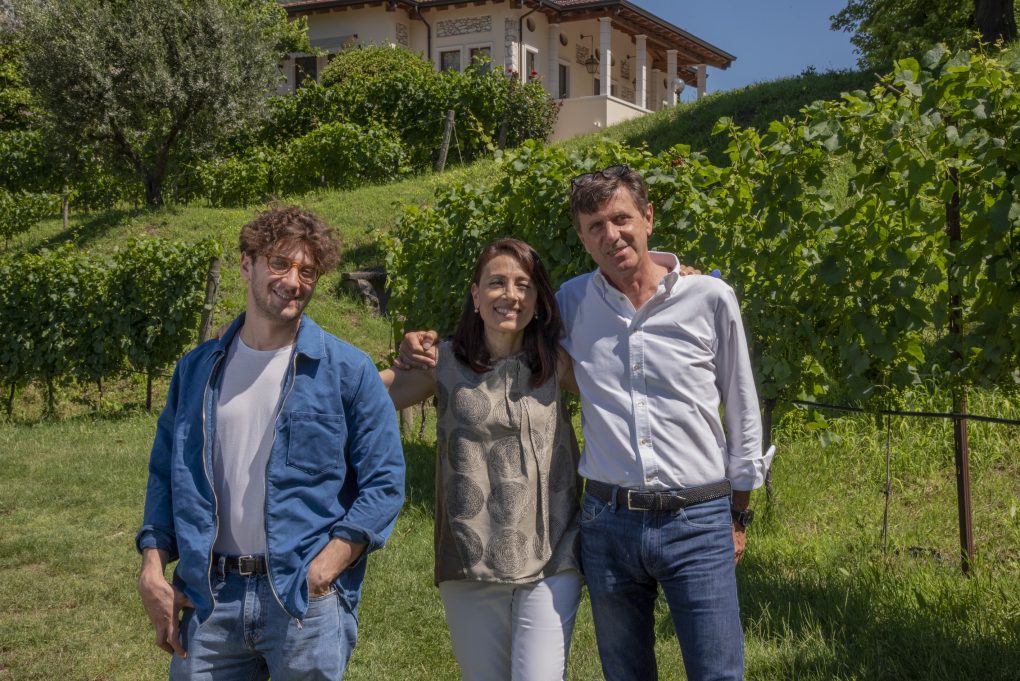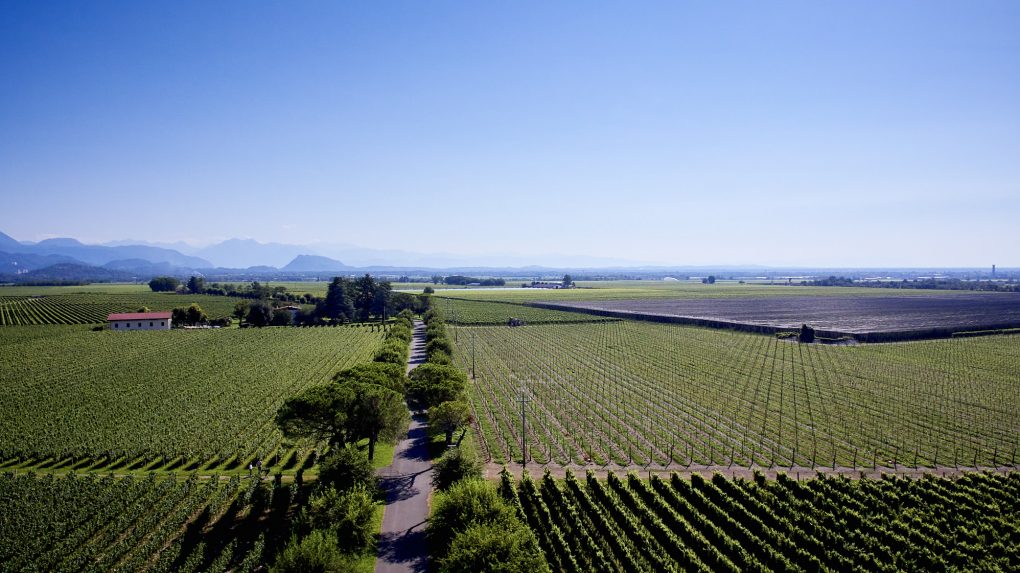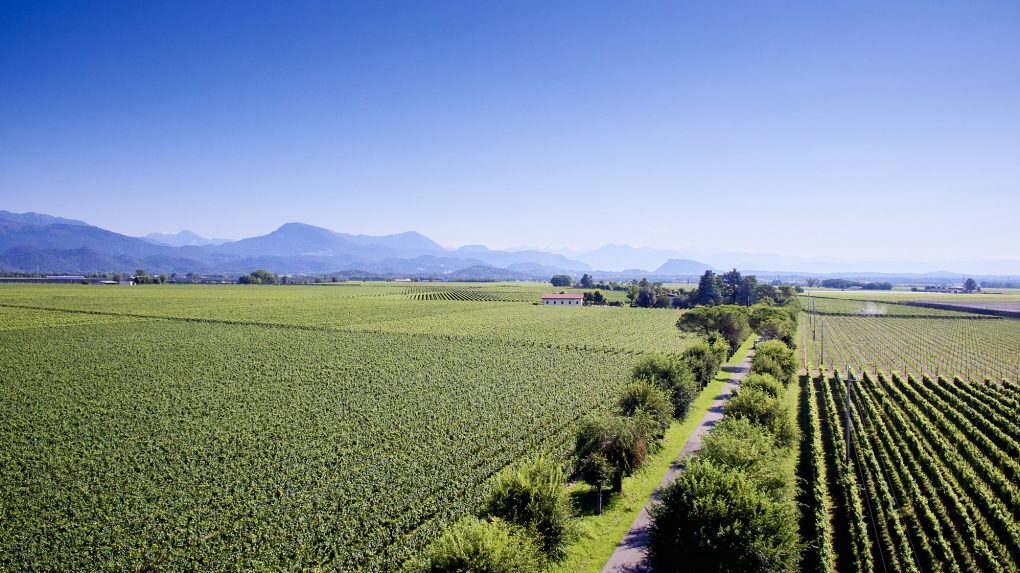Take a look at this quote:
“I’m from this valley. Like a stone or a plant, I’m bound to this land. I never go away without the intention of coming back, it’s natural. Here the teachings one receives come from the silence of small things: you get the notion of your own niche in the universe, and it becomes clear what you have to do. The rhythm of growing grapes and making wine is slow. It can take years, even generations.”
It’s eloquent, sensitive, and describes an enlightened approach to winemaking that demonstrates a profound respect for the natural world. I would like to be able to say that the quote came from me, but it’s actually from Albino Armani, the current man at the helm of the over 400-year-old, family owned, Albino Armani Viticoltori dal 1607, and his credo governs every step of the wine production process at Albino Armani.

A number of wineries in Italy, throughout the world in fact, have shifted their focus to more modern and environmentally sustainable methods of wine production because it’s the responsible thing to do. The generations-old philosophy governing winemaking at each of Albino Armani’s 5 estates involves making wines that fully express the terroir, culture, and history of the land, using minimally invasive and environmentally sustainable techniques, evolved over years of continuous research and development. These 5 estates are located in the Veneto, Trentino, and Friuli-Venezia Giulia. Together, they comprise 330 hectares of vineyards.
Father and son team Antonio and Albino focus on cultivating indigenous varietals from the Adige Valley because they believe these grapes best represent the distinct identity of this land. They also take care to protect the integrity of these autochthonous varieties by planting seeds that they know will germinate for years to come. The Albino Armani “Conservatoria” vineyard contains 13 ancestral varietals, 2 of which have been in production for the past few years. These include the “foja tonda,” and the “nera dei baisi.”

Albino Armani produces around 4 million bottles of wines annually and enjoys worldwide distribution. It does this using traditional and environmentally sustainable production techniques that reflect the centuries-old cultural practices of the Trentino Vallagarina within the Trentino-Alto Adige Südtirol region.
Albino Armani has been National Quality System for Integrated Production, SQNPI-certified for the past 2 years. The focus of the National Quality System for Integrated Production is to minimize the use of chemicals, and the negative impact of necessary farming practices such as irrigation and fertilization on the natural ecosystem and environment of agriculturally viable land.
Albino Armani occupies a pair of territories within the Trentino-Alto Adige. The vineyards in this area are located on either side of the Adige River at the base of Monte Baldo and the Lessinia Mountains. The morainic and alluvial soil is rich and fertile, and the pergola trentina is the vine training method used here. The microclimate, characterized by cool days and cold nights, is influenced by the neighboring Lake Garda.


The Sequals at Albino Armani Vineyards
The Monte Baldo-based vineyards are located in Crosano. The grapevines are cultivated on black basalt soil located on steep terraces at an altitude of 600-700 meters above sea level. It’s great territory for producing crisp and fruit and mineral-driven white wines.
The vineyards located in Vallagarina have a unique combination of soils including limestone, porphyry, and basalt. The variations in the composition of the soils in this territory make it well-suited to planting a number of grapes that thrive in a cool climate, with
big variations between day and nighttime temperatures, and gusty winds,
The vineyards in the Veneto can be found in 2 territories. The first, the Sequals, lies in the famed Friuli Grave DOC wine region. The rocky soil composition here is predominantly gravel and stone. It can be arduous cultivating grapes under these soil conditions, but careful and meticulous approach to the production process can and does yield wines of rare beauty. A copper wall-lined cellar and a winery equipped with the latest winemaking techniques co-exists in aesthetic harmony with the surrounding rustic environment. These modern practices, careful selection of the right autochthonous and international varietals to cultivate on rocky soil, in addition to cold temperature conditions, and expert winemaking know-how, result in wines that are particularly distinctive to this area.
Two vineyards, one in Lestans, and the other in Valeriano, occupy the territory of the
Magredis highlands. These vineyards are located in the northern edge of Friuli. The climate is influenced by the breezes coming off the Adriatic Sea that gradually grow cooler as they approach the mountains, and the difference between daytime and nighttime temperatures is considerable. The stony soil in Lestans, as well as the clayey soil in Valeriano, present challenges for growing grapes but the small clusters that do emerge from these soils are full of concentrated flavor.
The Glera grapes used to produce the sparkling Albino Armani Prosecco DOCG Extra Dry Conegliano Valdobbiadene are grown on the stone-rich soils of the hilltop vineyards in Treviso’s Conegliano Valdobbiadene. The guyot system is used to train the vines, and effervescence is achieved by way of the charmat method of secondary fermentation.
This prosecco is soft and delicate, with aromas of orchard fruit, white flowers, and herbs, and notes of harvest ripe peaches and pears, as well as fresh sage and grass. It’s extra dry – between 12 to 17 grams of residual sugar – so sweeter than your standard brut. It’s equally ideal as an apertif and an accompaniment to an assortment of cheeses, charcuterie, and seafood, as well as to spicy Asian cuisines.
The grapes for the Albino Armani Pinot Grigio Corvara Valdadige DOC are grown on morainic and alluvial soil-rich vineyards situated in the southern part of Valdadige in the Veneto. A combination of pergola trentina and guyot vine training methods are used to cultivate the grapes. The grapes are fermented in stainless steel tanks, and aged in its yeasts before being bottled. This pinot grigio is bright and lively, with aromas of citrus and orchard fruit, mint, and sage, and notes of lime, pear, green apple, and verdant herbs. It’s perfect with simply prepared and lighter fare including seafood and pasta salads, and steamed, grilled, and baked fish and poultry.
The pinot grigio for the Albino Armani Pinot Grigio Colle Ara Valdadige Terradeiforti DOC are also cultivated on vineyards located in the southern part of Valdadige. The vines are trained using the guyot system, and they are planted on calcareous-rich soil. The softly pressed grapes are cold macerated for a night to preserve their natural freshness. The wine is then aged with its yeasts in stainless steel vats and then in oak before it is bottled. This pinot grigio gives off beautiful aromas of orchard fruit and pomegranate, and round notes of peach, apricot, and papaya.. Baked and roasted poultry and pork seasoned with delicate spices, as well as an array of cream sauce-based pasta dishes pair well with this lovely pinot grigio.
The vineyards in Dolce can be found in 2 territories. These are Valdadige and Marano di Valpolicella. Dolce, situated between Trentino and Veneto, is near and dear to the heart of Albino Armani. You can find the headquarters here, where every step in the wine production process is carefully conceived. The vineyards in Valdadige enjoy a continental climate. Day and nighttime temperatures vary greatly, and there’s plenty of sunlight, factors that help grapes reach their full ripening potential. There is a steady cooling wind coming off Lake Garda, and the gravel-rich soil gets good drainage.
A number of autochthonous grapes, including those used to produce Amarone, are grown in the mineral-rich, volcanic soil of the hilltop vineyards of Marano in Valpolicella Classica. The climate is typical of that found at these elevations, with steady winds descending from the Lessinia Mountains accounting in part for cool nighttime temperatures. The Corvinone, Corvina, and Rondinella grapes used to make the Albino Armani Amarone della Valpolicella Cuslanus DOCG Classico Riserva are grown on the calcerous and volcanic soil-rich hillside vineyards located 300 to 500 meters above sea level. in Valpolicella Classico’s Marano Valley. The grapes undergo a drying process on straw mats known as appassimento in drying rooms called fruttaio to maximize the sugar, aromatics, and structure of the grapes. The grapes are softly pressed before undergoing fermentation with their skins for an extended length of time to achieve both richness of flavor and color concentration. The wine is aged in tonneaux, or large oak barrels, before being aged once more in bottles for 4 years.
This Amarone is elegant and supple, with fragrant aromas of ripe dark stone fruit and berries, as well as black pepper, chocolate, and coffee, and lush notes of raspberries, cherries, and plums, as well as mocha, earth, and oak. This balanced wine has good structure and well-rounded tannins that will continue to soften with aging.
This wine complements robust red meat-centered dishes including
braised beef, lamb, and duck. It is an equally suitable wine for lingering over after a fine meal.

Be First to Comment